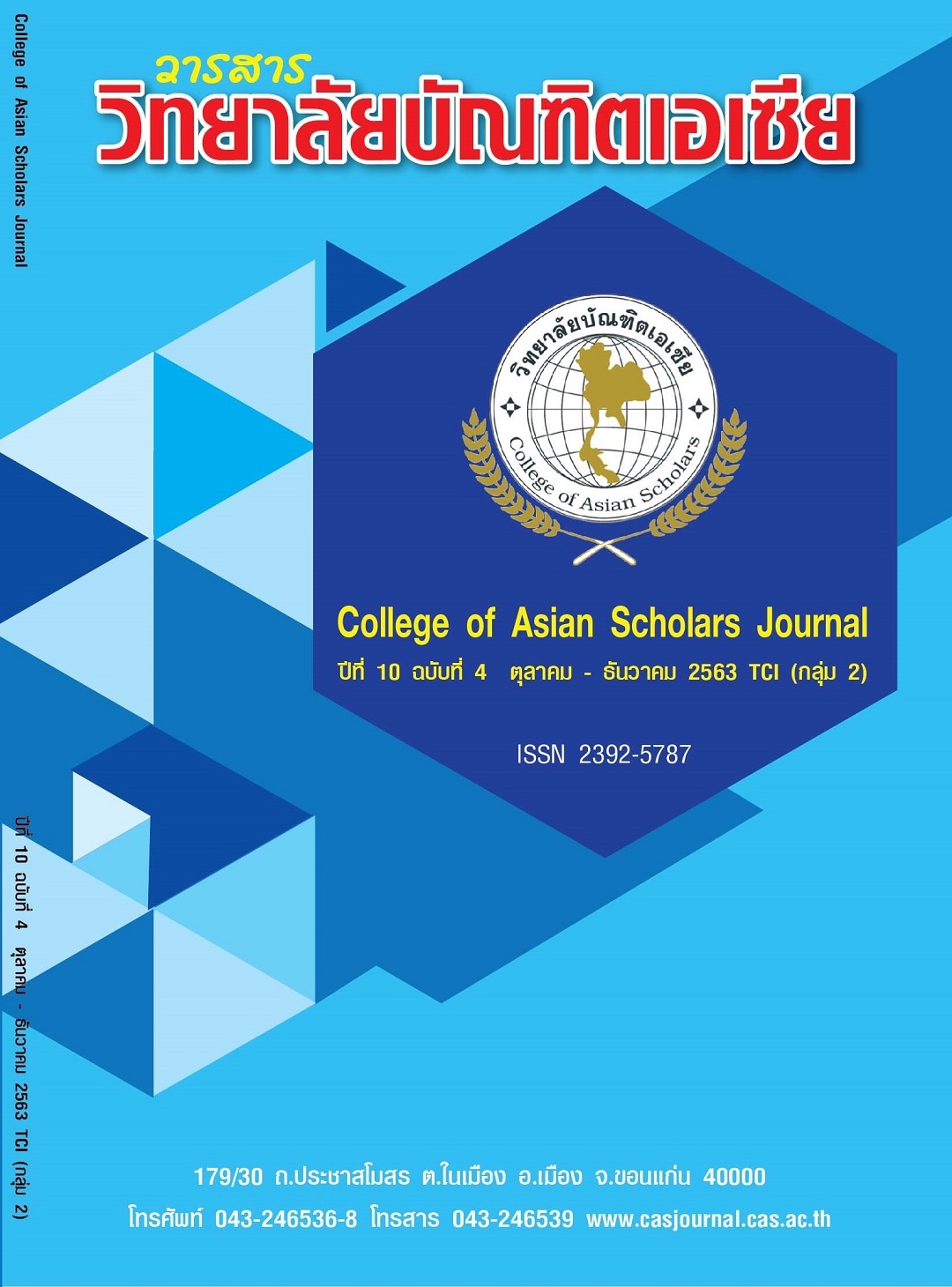ไฟล์ ดาวน์โหลด |
1613382101-2-ED029-T(16-23).pdf |
|||||||||
|
ชื่อผู้วิจัย อนงค์นาถ ทองจะโป๊ะ
|
|||||||||
| บทคัดย่อ ภาษาไทย |
การวิจัยครั้งนี้มีวัตถุประสงค์ 1) เพื่อศึกษาองค์ประกอบของภาวะผู้นำเชิงสร้างสรรค์ของผู้บริหารสถานศึกษา สังกัดสำนักงานเขตพื้นที่การศึกษามัธยมศึกษา เขต 25 2) เพื่อศึกษาระดับของภาวะผู้นำเชิงสร้างสรรค์ของผู้บริหารสถานศึกษา สังกัดสำนักงานเขตพื้นที่การศึกษามัธยมศึกษา เขต 25 และ 3) เพื่อศึกษาแนวทางการพัฒนาภาวะผู้นำเชิงสร้างสรรค์ของผู้บริหารสถานศึกษา สังกัดสำนักงานเขตพื้นที่การศึกษามัธยมศึกษา เขต 25 การวิจัยครั้งนี้แบ่งออกเป็น 3 ระยะ คือ ระยะที่ 1 ผู้ทรงคุณวุฒิประเมินองค์ประกอบและพฤติกรรมบ่งชี้ของภาวะผู้นำเชิงสร้างสรรค์ของผู้บริหารสถานศึกษา จำนวน 5 ท่าน โดยใช้วิธีการเลือกแบบเจาะจง (Purposive Sampling) เครื่องมือที่ใช้ ได้แก่ แบบประเมิน ระยะที่ 2 กลุ่มตัวอย่าง ได้แก่ ผู้บริหารสถานศึกษาและครูหัวหน้ากลุ่มสาระการเรียนรู้ สังกัดสำนักงานเขตพื้นที่การศึกษามัธยมศึกษา เขต 25 จำนวน 260 คน ระยะที่ 3 สัมภาษณ์สถานศึกษาที่มีวิธีปฏิบัติเป็นเลิศ (Best Practice) โรงเรียนหนองเสาเล้าวิทยาคาร ผู้ให้ข้อมูลสำคัญ คือ ผู้บริหารสถานศึกษาและครูหัวหน้ากลุ่มสาระการเรียนรู้ เครื่องมือที่ใช้ ได้แก่ แบบสัมภาษณ์แบบกึ่งมีโครงสร้าง ผลการวิจัยพบว่า 1. องค์ประกอบภาวะผู้นำเชิงสร้างสรรค์ของผู้บริหารสถานศึกษา สังกัดสำนักงานเขตพื้นที่การศึกษามัธยมศึกษา เขต 25 มีจำนวน 5 องค์ประกอบ ได้แก่ 1) การมีความคิดริเริ่มสร้างสรรค์ 2) การมีวิสัยทัศน์ 3) การมีปฏิสัมพันธ์ 4) การทำงานเป็นทีม และ 5) การมีความยืดหยุ่น 2. ระดับภาวะผู้นำเชิงสร้างสรรค์ของผู้บริหารสถานศึกษา สังกัดสำนักงานเขตพื้นที่การศึกษามัธยมศึกษา เขต 25 โดยภาพรวมอยู่ในระดับมาก เมื่อพิจารณาเป็นรายด้าน พบว่า ด้านที่มีค่าเฉลี่ยสูงสุด คือ ด้านการมีวิสัยทัศน์ รองลงไป คือ ด้านการทำงานเป็นทีม ด้านการมีปฏิสัมพันธ์ ด้านการมีความยืดหยุ่น และด้านการมีความคิดริเริ่มสร้างสรรค์ตามลำดับ เมื่อจำแนกตามขนาดของโรงเรียน พบว่า ภาพรวมของโรงเรียนขนาดใหญ่พิเศษมีระดับภาวะผู้นำ ค่าเฉลี่ยสูงที่สุด และ ภาพรวมค่าเฉลี่ยต่ำที่สุดคือโรงเรียนขนาดเล็ก แต่โดยภาพรวมขนาดโรงเรียน ทั้ง 4 ขนาด อยู่ในระดับมาก 3. แนวทางการพัฒนาภาวะผู้นำเชิงสร้างสรรค์ของผู้บริหารสถานศึกษา สังกัดสำนักงานเขตพื้นที่การศึกษามัธยมศึกษา เขต 25 สถานศึกษาที่มีวิธีปฏิบัติเป็นเลิศ (Best Practice) โรงเรียนหนองเสาเล้าวิทยาคาร สังกัดสำนักงานเขตพื้นที่การศึกษามัธยมศึกษา เขต 25 พบว่า แนวทางการพัฒนาด้านการมีความคิดริเริ่มสร้างสรรค์ ได้แก่ 1) การมีความคิดริเริ่ม 2) การมีความคล่องตัวในการคิด 3) การมีความคิดยืดหยุ่นในการคิด และ 4) การมีความคิดละเอียดลออในการคิด แนวทางการพัฒนาด้านการมีความยืดหยุ่น ได้แก่ 1) คิดหาคำตอบได้อย่างอิสระ 2) ปรับตัวตามสถานการณ์ต่าง ๆ 3) เปิดรับความคิดใหม่ ๆ อย่างอิสระ และ 4) สร้างบรรยากาศในการทำงานที่ดีในการทำงานแนวทางการพัฒนาด้านการมีปฏิสัมพันธ์ ได้แก่ 1) การสร้างความสัมพันธ์ 2) การส่งเสริมสนับสนุน และ 3) การสร้างความคุ้นเคย แนวทางการพัฒนาด้านการทำงานเป็นทีม ได้แก่ 1) มีเป้าหมายและวัตถุประสงค์ร่วมกัน 2) สนับสนุนความไว้วางใจต่อกัน 3) การติดต่อสื่อสารที่ดี 4) สร้างความร่วมมือระหว่างสมาชิกในทีมงาน และ 5) มีการพัฒนางานอย่างต่อเนื่อง แนวทางการพัฒนาด้านการมีวิสัยทัศน์ ได้แก่ 1) การสร้างวิสัยทัศน์ 2) การเผยแพร่วิสัยทัศน์ 3) การปฏิบัติตามวิสัยทัศน์ และ 4) การเป็นแบบอย่างที่ดี |
|||||||||
| คำสำคัญ | ||||||||||
| บทคัดย่อ ภาษาอังกฤษ | The objectives of this research were: 1) to study the creative leadership components of the school administrators. Under the Office of the Secondary Education Service Area 25, 2) to study the level of creative leadership of the school administrators. Under the Office of the Secondary Education Service Area 25 and 3) to study guidelines for the development of creative leadership of school administrators. Under the Office of the Secondary Educational Service Area 25. The research was divided into 3 phases; phase 1) evaluation for confirm elements of the creative leadership for the school administrators by 5 experts which selected through the purposive sampling. The instruments used were evaluation form, Phase 2) the sample group were 260 the school administrators and teachers under the Secondary Educational Service Area Office 25 and Phase 3) interview the schools with best practice (Best Practice), Nong Sao Laow Wittayakarn School, informants the key were school administrators and teachers, heads of learning subjects. The instruments used were semi-structured interviews. The results of this research found that: 1) The elements of the creative leadership of the school administrators under the Secondary Educational Service Area Office 25 consisted of 5 components which were 1) Creative thinking, 2) Vision, 3)Interaction, 4) Team works and 5) flexibility. The overall of 5 elements were in the highest level. 2) The creative leadership level of school administrators under the Office of the Secondary Educational Service Area 25, overall at a high level. When considered individually, it was found that the side with the highest average was vision. Team work interaction flexibility and creativity. When classified by school size, it was found that the overview of extra-large schools had a level of leadership the highest average and overall lowest average were small schools. But overall, all 4 school sizes were at a high level. 3) The creative leadership development guidelines for school administrators under the Office of the Secondary Education Service Area 25, the school with excellent practice (Best Practice), Nong Sao Laow Wittayakarn School, under the Office of the Secondary Educational Service Area 25, it was found that the guidelines for creative development included: 1) initiative, 2) flexibility in thinking, 3) flexible thinking and 4) Having a deliberate thought flexibility development approaches included 1) think for answers freely, 2) adapt to different situations, 3) open to new ideas independently and 4) create a good working environment. Interaction development approaches included 1) building relationships, 2) promoting and 3) building familiarity. Teamwork development approaches included 1) having common goals and objectives, 2) fostering trust, 3) good communication, 4) building cooperation among team members and 5) developing effective work development. Continuously Vision development approaches included 1) creating a vision, 2) disseminating the vision, 3) implementing the vision and 4) being a good role model. The objectives of this research were: 1) to study the creative leadership components of the school administrators. Under the Office of the Secondary Education Service Area 25, 2) to study the level of creative leadership of the school administrators. Under the Office of the Secondary Education Service Area 25 and 3) to study guidelines for the development of creative leadership of school administrators. Under the Office of the Secondary Educational Service Area 25. The research was divided into 3 phases; phase 1) evaluation for confirm elements of the creative leadership for the school administrators by 5 experts which selected through the purposive sampling. The instruments used were evaluation form, Phase 2) the sample group were 260 the school administrators and teachers under the Secondary Educational Service Area Office 25 and Phase 3) interview the schools with best practice (Best Practice), Nong Sao Laow Wittayakarn School, informants the key were school administrators and teachers, heads of learning subjects. The instruments used were semi-structured interviews.
The results of this research found that:
1) The elements of the creative leadership of the school administrators under the Secondary Educational Service Area Office 25 consisted of 5 components which were 1) Creative thinking, 2) Vision, 3)Interaction, 4) Team works and 5) flexibility. The overall of 5 elements were in the highest level.
2) The creative leadership level of school administrators under the Office of the Secondary Educational Service Area 25, overall at a high level. When considered individually, it was found that the side with the highest average was vision. Team work interaction flexibility and creativity. When classified by school size, it was found that the overview of extra-large schools had a level of leadership the highest average and overall lowest average were small schools. But overall, all 4 school sizes were at a high level.
3) The creative leadership development guidelines for school administrators under the Office of the Secondary Education Service Area 25, the school with excellent practice (Best Practice), Nong Sao Laow Wittayakarn School, under the Office of the Secondary Educational Service Area 25, it was found that the guidelines for creative development included: 1) initiative, 2) flexibility in thinking, 3) flexible thinking and 4) Having a deliberate thought flexibility development approaches included 1) think for answers freely, 2) adapt to different situations, 3) open to new ideas independently and 4) create a good working environment. Interaction development approaches included 1) building relationships, 2) promoting and 3) building familiarity. Teamwork development approaches included 1) having common goals and objectives, 2) fostering trust, 3) good communication, 4) building cooperation among team members and 5) developing effective work development. Continuously Vision development approaches included 1) creating a vision, 2) disseminating the vision, 3) implementing the vision and 4) being a good role model.
|
|||||||||
| Keyword | Creative Leadership of the School Administrators, School Size, the Office of Khon Kaen Secondary Educational Service Area 25 | |||||||||
อนงค์นาถ ทองจะโป๊ะ
2 บทความ| ชื่อ - สกุล | วารสาร | ไฟล์ |
หน้า |
|
|---|---|---|---|---|

|
อนงค์นาถ ทองจะโป๊ะ CAS485 |
บทเรียนที่เป็นแบบอย่างที่ดีในการจัดการขยะมูลฝอยจังหวัดขอนแก่น : กรณีศึกษาเปรียบเทียบเทศบาลตําบลพระลับและเทศบาลเมืองศิลา | ||

|
อนงค์นาถ ทองจะโป๊ะ CAS1012 |
แนวทางการพัฒนาภาวะผู้นำเชิงสร้างสรรค์ของผู้บริหารสถานศึกษาสังกัดสำนักงานเขตพื้นที่การศึกษามัธยมศึกษา เขต 25 |

1.jpg)
1.jpg)
1.jpg)
.1.jpg)